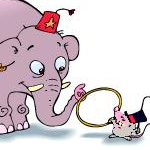 There were many thoughtful comments to last week’s post, including provocative reflections on the power imbalance between funders and grantees and speculation as to whether restructuring the relationship as a ‘partnership’ might be feasible or desirable. In recent years, a ‘strategic partnership’ approach (commonly used by venture philanthropists seeking to, for example, fund nonprofits to make and distribute mosquito nets in the Third World), has been embraced by some arts funders. But is this a positive development for arts groups?
There were many thoughtful comments to last week’s post, including provocative reflections on the power imbalance between funders and grantees and speculation as to whether restructuring the relationship as a ‘partnership’ might be feasible or desirable. In recent years, a ‘strategic partnership’ approach (commonly used by venture philanthropists seeking to, for example, fund nonprofits to make and distribute mosquito nets in the Third World), has been embraced by some arts funders. But is this a positive development for arts groups?
Most arts funders (even those that are endeavoring to be ‘partners’) are making miniscule grants relative to arts organizations’ operating budgets, or even the budgets of their individual programs in many cases. If an arts organization is cobbling together a bunch of $5-$25,000 grants to fund some portion of its operations (as many of them are), how many authentic ‘partnerships’ (read: masters) can it reasonably fulfill (read: serve)?
For that matter, how many ‘partnerships’ can one funder reasonably sustain? I was interested to learn from a presentation by a major venture philanthropist that his foundation had determined that it could manage no more than about 30 projects at a time, because each ‘partnership’ required sustained financial support and significant time (read: involvement) of foundation staff.
Which raises another question: Do arts organizations want ‘partnership’ if it implies intense involvement? Furthermore, is such involvement appropriate when one is creating operas or art exhibitions? Witness the way some foundations and individual donors have, essentially, sought to coerce the National Portrait Gallery into reinstating A Fire in My Belly by artist David Wojnarowicz on the grounds that they have contributed to the exhibit Hide/Seek: Difference and Desire in American Portraiture.
It would appear that the National Portrait Gallery made the decision to remove the exhibit in response to political pressure from representatives of the US government, which might reasonably be considered a ‘partner’ given that the NPG receives several million dollars in federal appropriations each year. That other smaller ‘partners’ of the exhibit disagree with the decision is completely understandable (there seems to be near unanimity in the ‘art world’ that this was a scandalous turn of events); but that they expect to change the outcome, may not be. Unless these other funders and individual donors can pony up millions of dollars per year in operating support for the National Portrait Gallery, they are unlikely to have significant political leverage with it now, or in the future. And, reasonably, should they? Â
I sense that grant seekers are keen to use the term ‘partnership’ as they perceive that recasting the relationship as two entities jointly trying to achieve a great goal may help level the playing field and encourage meaningful underwriting in support of core programs for sustained periods of time (think: The Humana Festival at Actors Theatre of Louisville). Realistically, I don’t see many arts funders being able or willing to do this. Cynically, I think calling them partners (particularly those that are flying the ‘strategic philanthropy’ flag) may simply give them more power and lead them to expect more involvement and hoop jumping and achievement of outcomes, in exchange for what still amounts to relatively small amounts of restricted support.
Elephant and Mouse image by Gnurf, licensed at Shutterstock.com
